For true believers, the Bruegel room in Vienna’s Kunsthistorisches Museum must be the holy grail. Though paintings by the artist occupy two rooms in the Museum of Fine Arts in Brussels, they are interspersed with works by his two sons. But the room in Vienna is a concentrated showcase of the whole spectrum of Bruegel’s work: The Tower of Babel and The Procession to Calvary are major examples of works with a religious theme, while the three pictures from the seasons cycle illustrate Bruegel’s skill as a landscape painter. Then there are the depictions of everyday life portrayed in The Peasant Wedding and The Peasant Dance for which Bruegel is particularly renowned. Without question this was the high point of our pursuit of Bruegel across Europe.
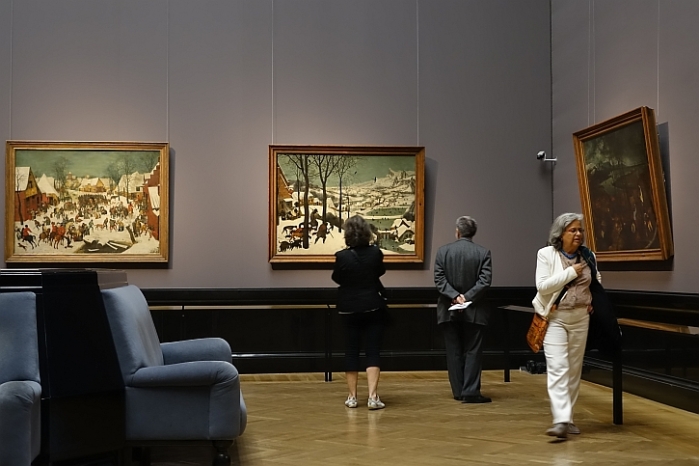
A few years ago, the idea came to us of pursuing Pieter Bruegel the Elder by visiting the European cities where his works are exhibited. We had seen his work in London and Madrid, and next we travelled to Brussels and Antwerp to view the fine collections there. Then, this summer, while in Berlin, we visited the Gemäldegalerie to see Two Monkeys and Netherlandish Proverbs before, madly perhaps, we took the sleeper to Vienna with the sole purpose of visiting the Kunsthistorisches Museum. Pursuing Bruegel around Europe was not an original idea: we had been inspired by Robert L Bonn’s, Painting Life, the author’s account of the same quest.
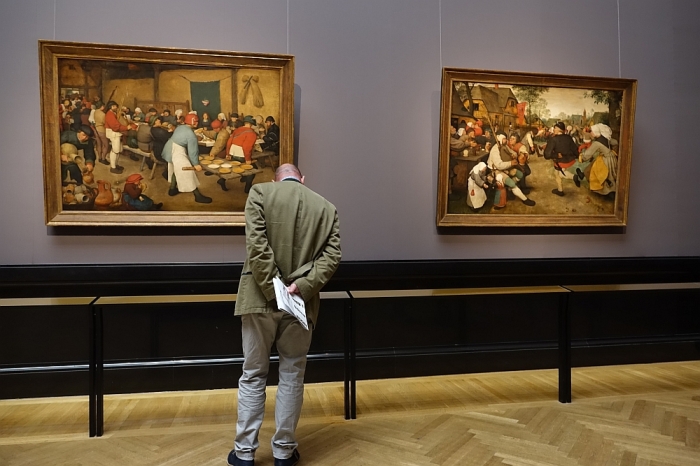
In this fantastic room it is difficult to know where to look first. It’s going to take me three posts to get down all my thoughts about the paintings in this room. In one I’ll look at paintings that explore themes of religion, politics and war; in another I’ll consider examples of the kind of work that resulted in the artist coming to be known, misleadingly, as ‘Peasant Bruegel‘.
But I’ll begin with three paintings from the Seasons cycle, done in 1565 for the wealthy Antwerp collector and patron of Bruegel, Niclaes Jonghelinck, who commissioned the sequence. The paintings later passed into the possession of the city of Antwerp as security for a bond that was not redeemed. In 1594 they were surrendered to the younger brother of the Hapsburg Emperor Rudolf II, who was the governor of the Netherlands. A few years later, the paintings were then transferred to Vienna.
Five paintings in the series survive: one is missing, since we know that Bruegel planned six pictures (probably depicting pairs of months, since the calendar in northern Europe was often divided into six seasons – two transitional seasons of early spring and early summer, as well as the familiar four).
By this time the genre of paintings of the seasons was fully developed in Netherlandish art. But in this sequence, Bruegel raises it to a new level. In Bruegel’s cycle human activities are observed against the broader canvas of the recurring cycle of change – of death and renewal – in nature. Human toil goes on endlessly amidst an indifferent nature.
Spring: The Gloomy Day
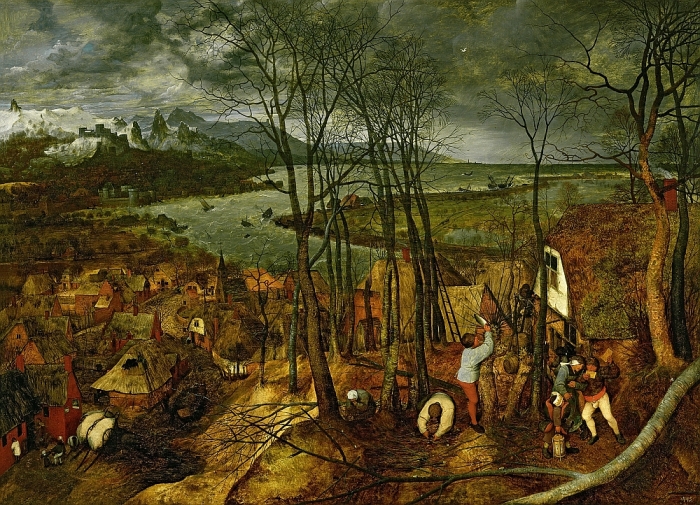
Gloomy Day presents the awakening of nature at the New Year which traditionally began in the Netherlands on March 1st. Therefore seen as the first painting in the sequence, the painting represents the first transitional season of late winter or early spring. In the foreground, seasonal tasks are being undertaken – collecting wood, cutting osiers (willow switches), and tying them in bundles. In the village below, a man is making repairs to a thatched roof.
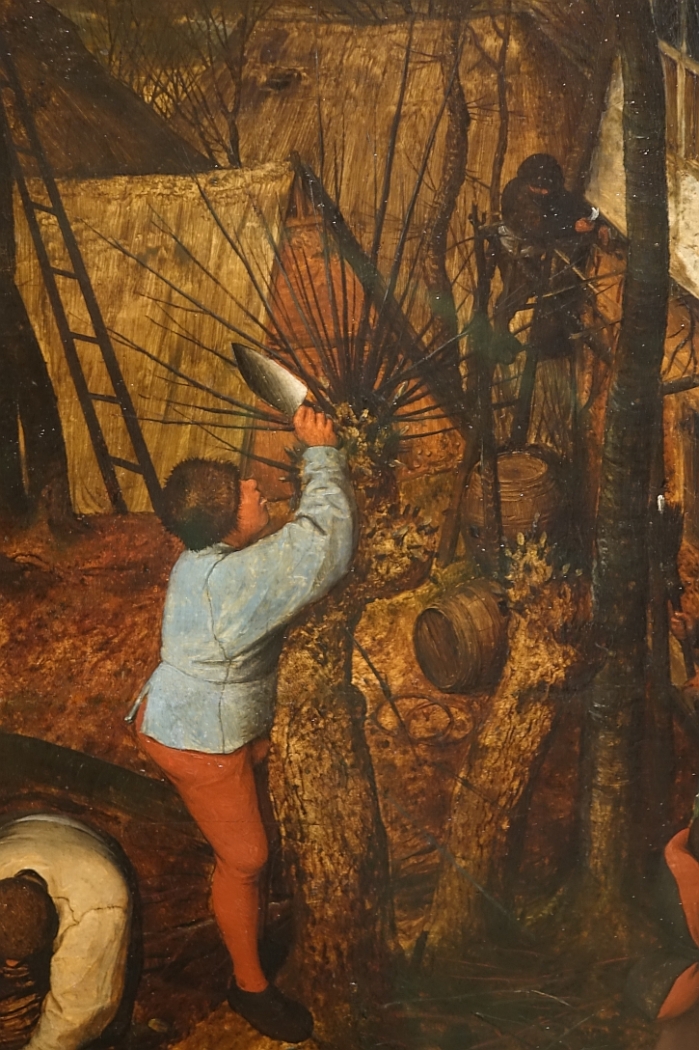
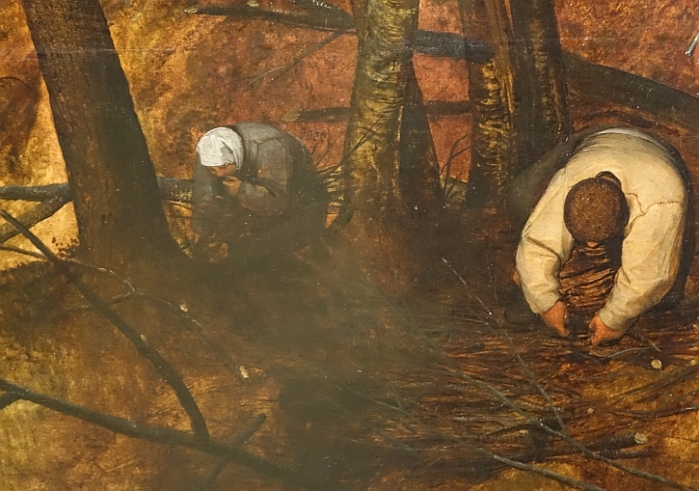
It’s carnival time – signified by the child with the paper crown, the lantern, and the man eating a waffle like the ones traditionally eaten during the carnival period. Down in the village, there are signs of celebration at the tavern, with music, dancing and a man pissing up the tavern wall.
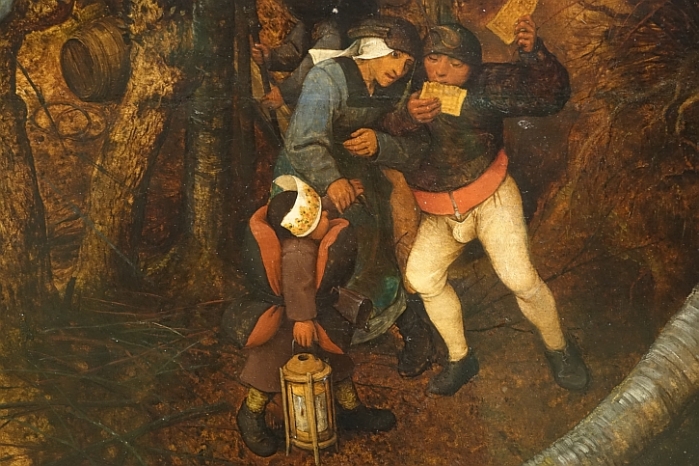
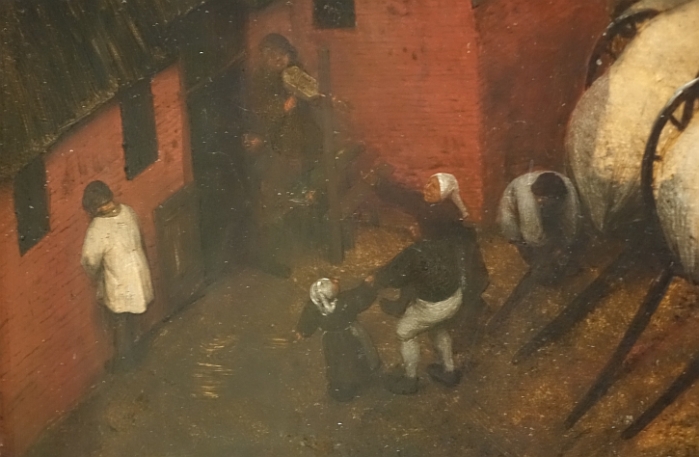
Beyond these human details, from the elevated viewpoint that is characteristic of the series, Bruegel presents a magnificent view of an vast landscape. In common with many of his landscapes, the painting incorporates features of the Flemish countryside (notably the detailed depiction of the village), as well as the kind of snow-covered mountainous terrain he would have seen passing over the Alps during his journey to Italy in 1553. Out to sea, a storm is raging, and ships have been swept ashore.

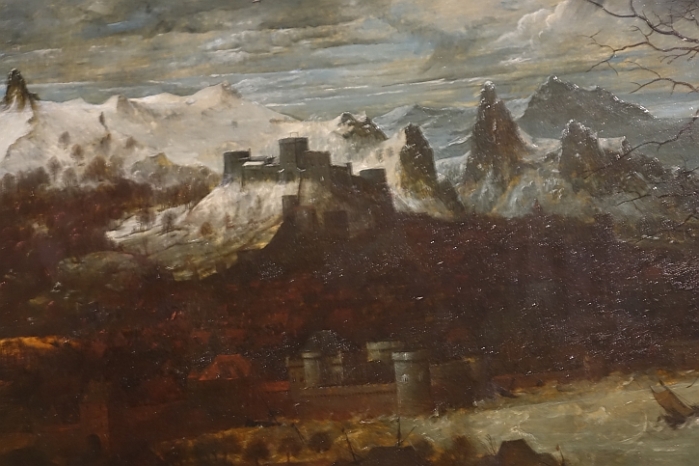
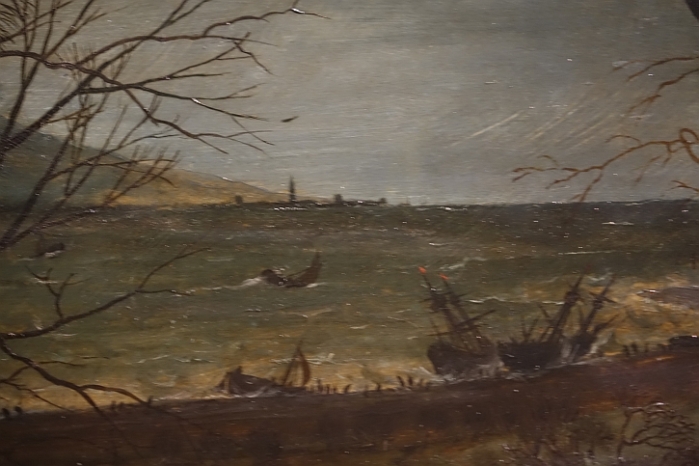
Under the leaden, threatening sky, all these details reinforce the sense of the insignificance of humanity in the face of implacable nature. But, the people in the picture persist in their endeavours, whilst celebrating carnival, marking rebirth and a brief release from the monotonous demands of daily life.
Summer: Haymaking
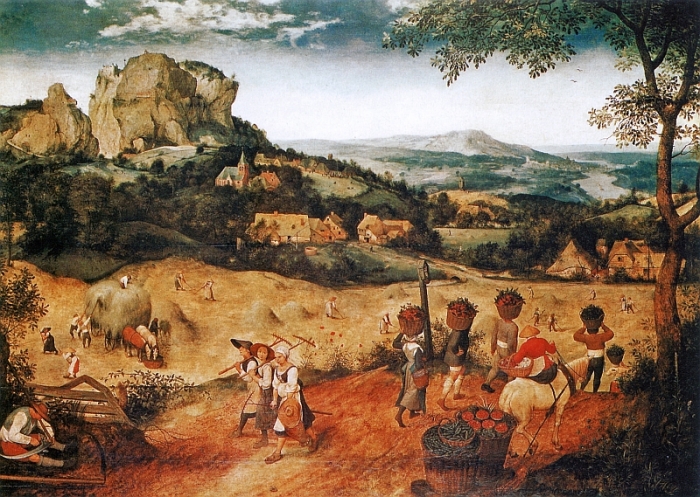
If, in Vienna, we could proceed through Bruegel’s cycle of the seasons, the next two paintings would be Haymaking (representing early summer) and The Harvesters (late summer). But the former is in a private collection, and the latter now hangs in the Metropolitan Museum of Art in New York.
Late summer: The Harvesters
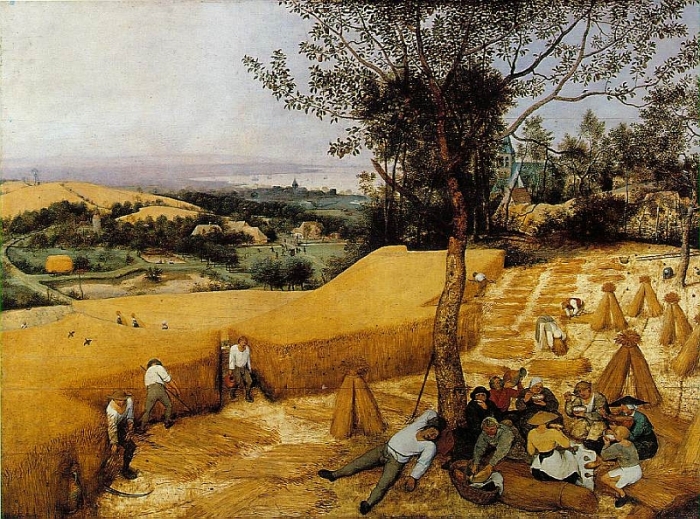
Bathed in golden light, the scene in Haymaking shows the most relaxed time of year for those who worked the land: for the moment, at least, much of the hard work has been done; the cut hay is being gathered in, a man sits and sharpens his scythe, and baskets of recently-picked cherries and strawberries overflow.
Yellow is the dominant colour in The Harvesters – the warm yellow of the ripe corn being mowed and sheathed by the labourers resting in the shade of the tree in the foreground, where they eat, drink and doze in the heat of a summer’s afternoon.
Autumn: The Return of the Herd

It’s autumn – probably some time in October or November – and Bruegel captures the mood with a colour scheme that contrasts warmer ochre and earth tones in the foreground with the colder blue tones of the river and distant mountains beyond.
The main subject, running in a diagonal from right to left, is the herd of cattle being prodded and guided towards winter quarters in the village by the herdsmen. The subject of a herd returning from summer pastures was not typical of Netherlandish painting, and there’s speculation that this is another example of Bruegel drawing upon impressions gained during his travels through Switzerland – where he would probably have seen cattle being driven down from the Alpine pastures, a key event in the peasant’s year in those parts, but a custom not necessary in the Netherlands.
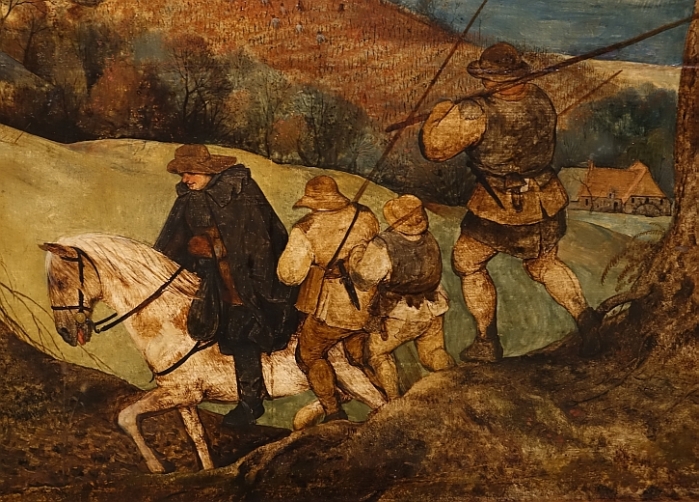
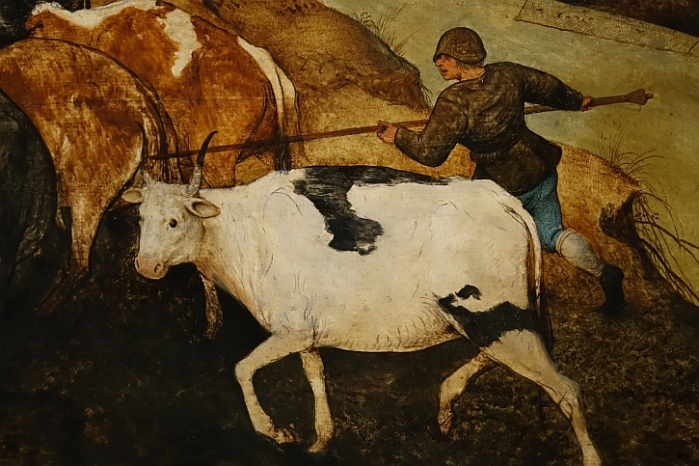
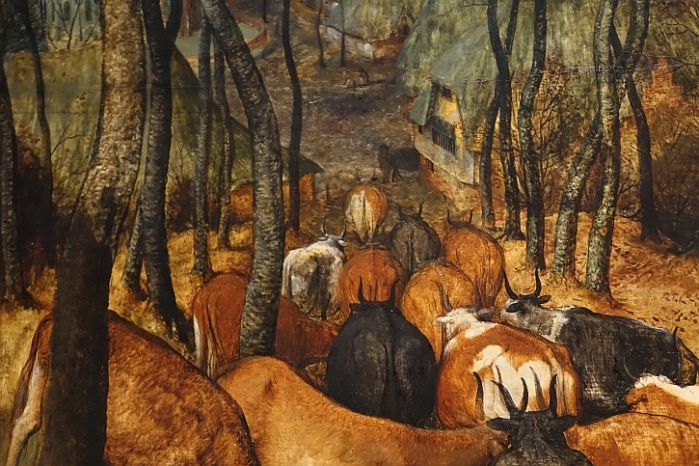
Bruegel’s depiction of the herd of cows is particularly fine: the backs of the animals are correctly proportioned as they make their up the woodland slope, their skins are rendered with great accuracy, and there’s a very real sense of their slow, ambling gait, and occasional pauses to savour wayside grass.
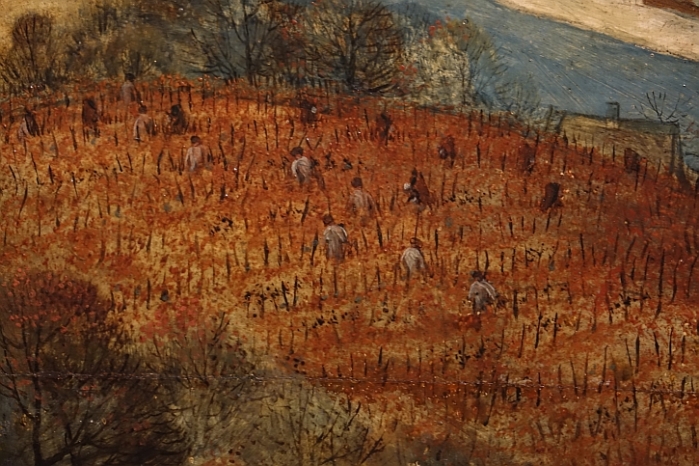
As with most of Bruegel’s canvases, the pleasure is in the details, executed with an intense attentiveness. For instance, in a field down by the river, labourers have more or less finished harvesting grapes from the sloping vineyard.
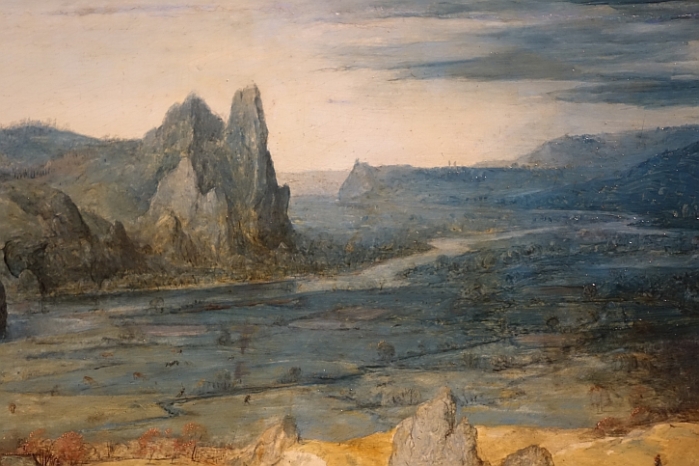
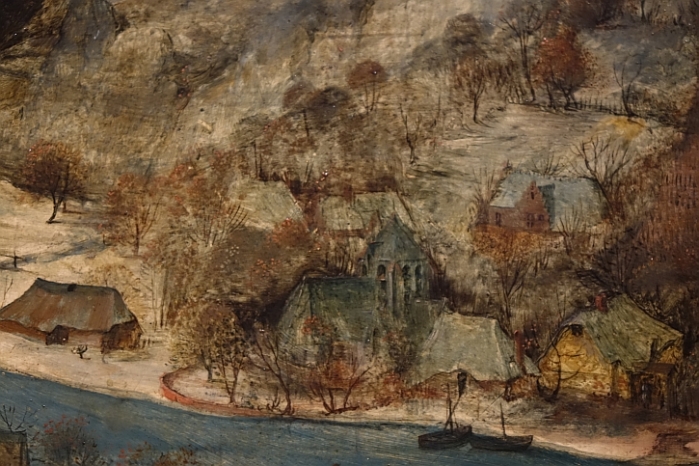
Once again, the mood is determined by Bruegel’s portrayal of the weather (a storm approaches) and the colouration of the landscape. The uncertainty of the autumn weather is underlined by the contrast between the stormy, blue-black clouds advancing from the upper right and the warmer brown tones of the hillside in the foreground. The river is bathed in sunshine, forming a line of demarcation between the two zones.
Winter: The Hunters in the Snow
The cycle of the seasons is completed with The Hunters in the Snow, one of Bruegel’s most celebrated images. The picture is dominated by two cold colours – the white of the snow and the pale green of sky and ice. Meanwhile, every living thing – people, trees, dogs, birds – is dark.
‘Never before in Western art had a painter managed to create such a convincing representation of the coldness, the silence, and the torpor of the winter landscape,’ writes William Dello Russo in a recent study of Bruegel.
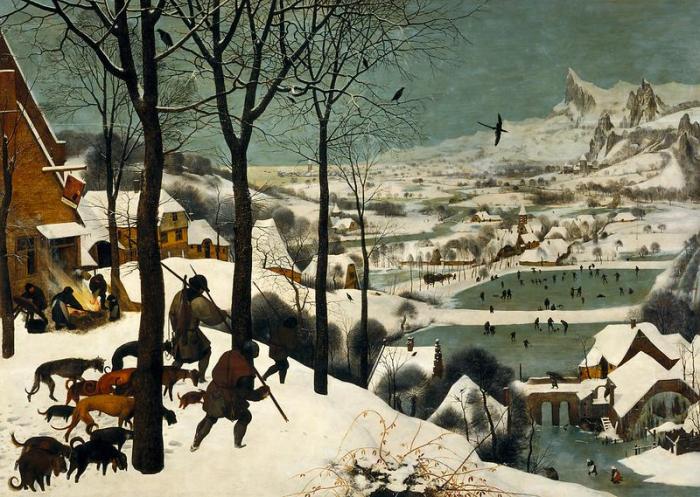
The row of trees that recedes from the foreground leads the eye towards the village and the frozen ponds below. There’s a real sense of the slow movement of dogs and men, leaving deep prints as they plod through the snow.
Hunters in the Snow, detail: a meagre solitary fox
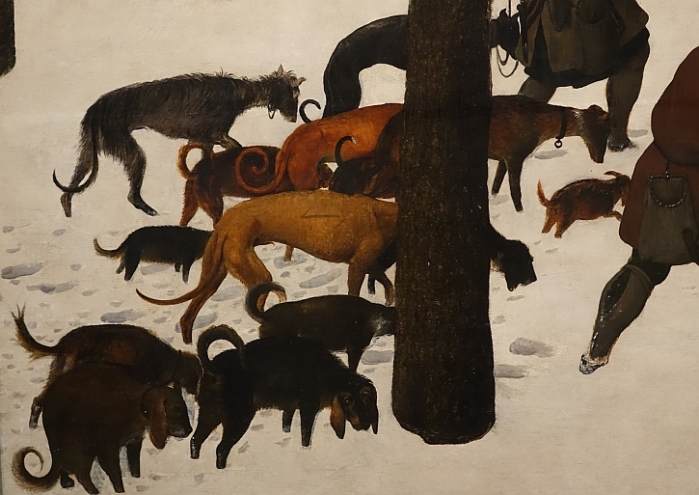
A group of hunters returns, descending to a village on the plain below on a cold, gloomy late afternoon in winter. They are accompanied by their pack of exhausted dogs, walking with lowered heads and tails between their legs. The hunt has not been particularly successful: a meagre single fox hangs from a spear slung over a man’s shoulder.
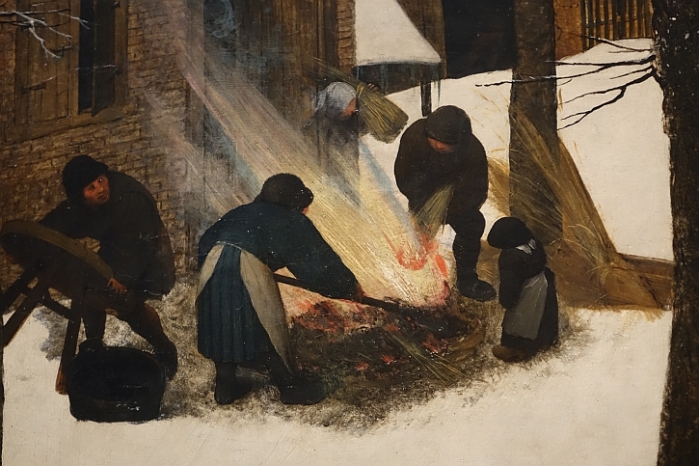

Our attention is drawn to the scenes of continuing activity in the village: to the left preparations are afoot to singe a pig over an open fire, while on the right adults and children skate on the frozen ponds, each figure detailed with terrific care. By the mill at lower right, its water wheel completely frozen, a woman carries a bundle of kindling on her back. Beyond the village church, someone crosses the frozen river on the ice, while a cart hauled by two horses and loaded with winter fuel is led past the ponds.
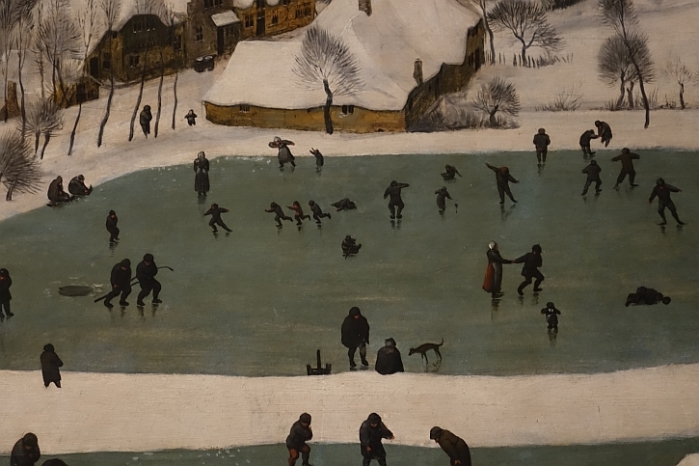
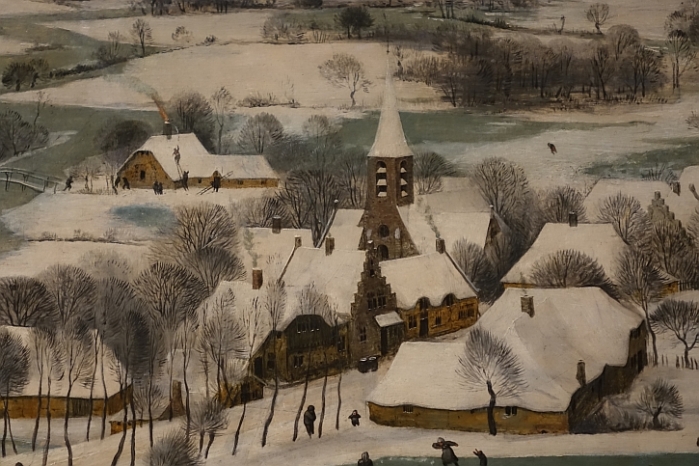
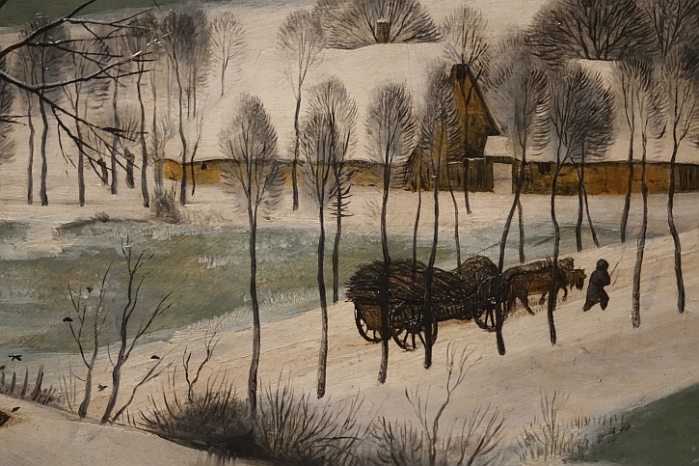
One detail that I really love in this painting are the birds. Four dark birds (possibly crows or starlings) sit among the bare branches of the trees in the foreground, while another (almost certainly a magpie; did Flemish country folk say, like us, ‘one for sorrow’?) is in flight.
In fact, according to the Swedish director Roy Andersson, it was the birds in Bruegel’s painting that inspired his recent film, A Pigeon Sat on a Branch Reflecting on Existence. In an interview Andersson explained:
The birds appear to be speculating: ‘What are the humans doing down there? Why are they so busy?’… A Pigeon Sat on a Branch consists of a bird’s panoramic view of the human condition, in which the bird not only reflects on human existence but also worries deeply about it, as I do myself. The pigeon is astonished that humans do not see an approaching apocalypse, though it is in man’s ability to avoid destroying the future for themselves. A Pigeon Sat on a Branch shows the looming apocalypse and offers the possibility to believe in our capacity to avoid it.
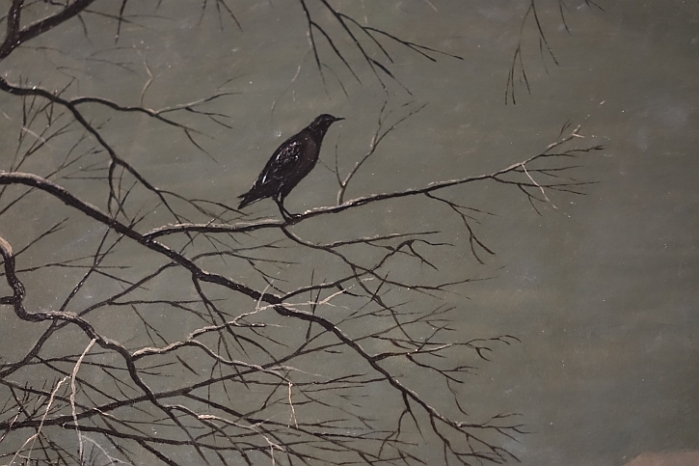
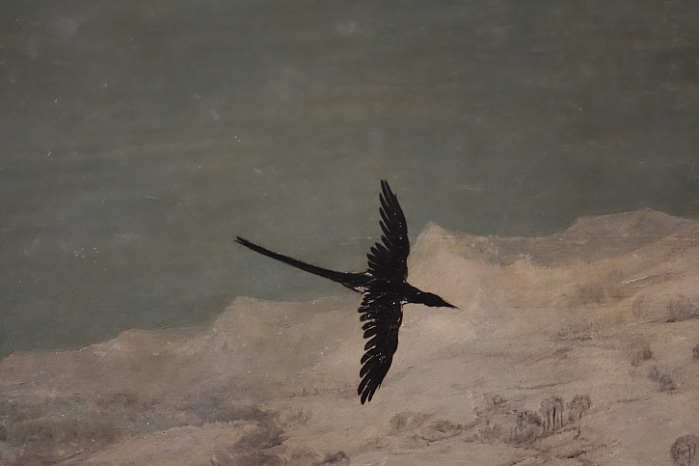
In an interesting article for the Guardian in 2006, Jonathan Jones connected this painting with Bruegel having experienced the winter of 1565 – the coldest winter at the time that anyone could remember, which turned out to be a harbinger of the Little Ice Age to come:
The world turned white, birds froze, fruit trees died, the old and young faded away. It was a shock – and a foreboding. This seemed to be more than just a cold winter. The climate was perceptibly changing, and that is what Bruegel’s snow scenes eerily record. All of them – from Hunters in the Snow painted in 1565, to Census in Bethlehem in 1566, to The Adoration of the Magi in 1567 – were made in response to that year and what it presaged.
If it was Bruegel’s intent to infuse his painting with a sense of climatic foreboding, it has certainly acquired that in our own time. In Tarkovsky’s film Solaris, in a space station orbiting a distant planet a reproduction of Bruegel’s Hunters in the Snow hangs in a lounge. As a chorale prelude for organ by Bach plays on the soundtrack, the astronauts stare at Bruegel’s memory of life on Earth.
In his Guardian piece, Jonathan Jones writes:
In modern cities, icy conditions are easily recreated by technology. Synthesised ice rinks have spread from Manhattan’s Rockefeller Centre to parks and museum terraces everywhere. Maybe this is what winter will become: a refrigerated carnival, an attempt to recreate artificially the cherished memories and folk tales of winters lost for ever. It’s a chilling thought that, for future generations on a radically altered Earth, Hunters in the Snow may fulfil just this purpose: preserving the idea, at least, of what a snowbound planet looked like, how human it was, how paradoxically warm and fun.
Jones continues: ‘Bruegel captured humanity’s double relationship with winter: we fear it and we love it. Surviving winter is part of what makes us human.’ Indeed, the most remarkable thing about Bruegel’s painting is that there are people everywhere. The frozen pond is covered with ice skaters. There are couples skating together holding hands, and there are children playing with wooden toys or chasing each other across the ice. There is a mother with a child, there are boys with a sled, there are skaters skating elegantly on their own and there are some who have fallen flat on their faces. There are people sitting at the edge of the lake putting their ice skates on, and there are others who are just watching.
Apart from the skaters, there are the people who are working: the woman with the bundle of branches on her back, the man leading the horses along the road, the people preparing the pig roast. On and on into the distance there are people, working or enjoying themselves in the snow and the cold.
So loved and admired is this painting that it has inspired several poems. This one is by John Berryman:
The three men coming down the winter hill
In brown, with tall poles and a pack of hounds
At heel, through the arrangement of the trees,
Past the five figures at the burning straw,
Returning cold and silent to their town,
Returning to the drifted snow, the rink
Lively with children, to the older men,
The long companions they can never reach,
The blue light, men with ladders, by the church
The sledge and shadow in the twilit street,
Are not aware that in the sandy time
To come, the evil waste of history
Outstretched, they will be seen upon the brow
Of that same hill: when all their company
Will have been irrecoverably lost,
These men, this particular three in brown
Witnessed by birds will keep the scene and say
By their configuration with the trees,
The small bridge, the red houses and the fire,
What place, what time, what morning occasion
Sent them into the wood, a pack of hounds
At heel and the tall poles upon their shoulders,
Thence to return as now we see them and
Ankle-deep in snow down the winter hill
Descend, while three birds watch and the fourth flies.
Next:
See also
- In pursuit of Bruegel: the full story

Have you read Headlong by Michael Frayn? It is a fictional discovery of the lost Seasons painting by Bruegel. Highly recommended. Well researched background, very entertaining and humorous.
In the Winter painting, I have noticed that very few commentators mention the chimney on fire in the village and the people with ladders trying to put it out. There is always so much to see in a Bruegel – the more you look the more you see!
Thanks for the reminder about the Frayn book – I came across a reference to it when I was researching the post, thought it sounded interesting, then forgot about it. I had noticed the chimney on fire – very seasonal! (I’m old enough to remember that, in the days when nearly everyone had a coal fire, chimneys would go on fire particularly in the later part of the winter as the soot built up in the chimney.)